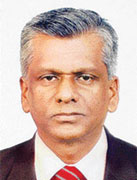Quality, a competitive weapon
By Dr Lalith Senaweera
 Organisations are concerned about increasing costs and always try to
find out ways and means of facing this challenge as it is vital for the
long term survival of organisations. However, many organisations fail to
determine the root causes for such cost increases as most organisations
are mainly focused on visible costs reflected in the accounts. Organisations are concerned about increasing costs and always try to
find out ways and means of facing this challenge as it is vital for the
long term survival of organisations. However, many organisations fail to
determine the root causes for such cost increases as most organisations
are mainly focused on visible costs reflected in the accounts.
 But if an organisation really assesses the internal activities the
actual picture may be entirely different due to many internal issues
such as waste within the organisation which may be high. If the
organisation has a sound approach to control waste it can cut down costs
and face the challenges of increasing costs to an extent. But if an organisation really assesses the internal activities the
actual picture may be entirely different due to many internal issues
such as waste within the organisation which may be high. If the
organisation has a sound approach to control waste it can cut down costs
and face the challenges of increasing costs to an extent.
To lead and operate an organisation successfully, it is important to
direct and control activities in a systematic, transparent and open
manner.
Managing an organisation is not an easy task unless and until its
activities are streamlined to avoid unwanted costs. It is necessary to
manage the quality of every process of the organisation to improve
performance of the organisation by providing quality products or
services to customers.
Customers expect the products or services they buy to meet or exceed
certain levels of performance. Conformance to specifications at all
times is, therefore, important to ensure that the product meets the
expected requirements in a consistent manner.
Managing quality
Despite widespread understanding of the importance of quality, many
organisations still face difficulties integrating quality into their
management efforts.
Due to the lack of proper understanding of the fundamental principles
of quality, many organisations consider setting up a quality culture
within an organisation as the job of the quality assurance department
and others in the organisation do things in an incorrect manner in their
day-to-day functions neglecting quality principles leading to waste.
|

Dr Lalith Senaweera |
Sometimes these lead to a delay in releasing products to the market,
service delays to customers, manufacture of defective products, re-work
or frequent break downs of machines, which are issues which need to be
controlled and managed to minimise costs. However, top management is not
always aware of structured approaches to problem solving.
They handle many problematic conditions in a superficial manner. Many
problems remain unresolved because of the inability to understand the
primary causes and the inter-action and effects of uncontrollable
sources such as the influence of the environment on the performance of
the organisation.
One way to improve performance is through an acceptable Quality
Management System incorporated with the functions of the organisation.
Role of quality management models
There is no need to reinvent the wheel to determine a suitable
quality management model to improve performance as a number of such
concepts and models have been introduced to the world..
Some of those are ISO 9001 Quality Management System, EFQM Excellence
model, Malcolm Baldrige Quality Award, Total Quality Management System
(TQM), Six Sigma, Lean Management System, Toyota Way, Deming's fourteen
points and SLNQA. These models are popular and are used by many
organisations in the world.
The ISO 9001 Quality Management System is considered as an
internationally accepted Quality Management reference standard to set up
effective Quality Management programs to focus on preventing defects
rather than detection of defects through inspection.
To reliably improve quality, an organisation should understand and
improve the processes that generates quality. Moreover, effective
quality management requires the support and commitment of employees at
all levels of the organisation to achieve organisational goals.
Total employee involvement is needed to implement the practices and
tools of the Quality Management System.
The ISO 9001:2008 specifies a need for a Quality Management System
where an organisation needs to consistently provide products and
services that meets statutory and regulatory requirements to enhance
customer satisfaction through the effective application of the system,
including processes for continual improvement of the system and the
assurance of conformity.
All requirements of ISO 9001:2008 are generic and are applicable to
all organisations, regardless of type, size and product.
The Malcolm Baldrige National Quality Award was set up by the US
congress in 1987 to promote quality management practices and improve
products of the American industry. The award 'Criteria for Performance
Excellence' sets up a framework for integrating total quality principles
and practices in any organisation.
The award stimulates organisations to attain excellence in quality
and productivity while obtaining a competitive edge through improved
products and services.
The award criteria includes seven requirements.This award scheme was
introduced by the European Community to pass on the message of the
importance of quality to meet the challenges in the global market and to
improve the quality of life of the people.
The results criteria consists of people satisfaction, customer
satisfaction, impact on society and business results.Excellence awards
are designed to celebrate and recognise organisations that achieve high
levels of performance - not only in what they achieve, but also in how
they achieve it.
Excellence awards use models - frameworks that not only form the
basis of the assessment criteria, but which can also be used to drive
improvements and benchmark performance and be used to manage specific
activities such as procurement.
Total Quality Management is a management approach that originated in
the 1950s. It became popular in the early 1980s. Total Quality is a
description of the people, culture, attitude and organisation of a
company that strives to provide customers with products and services
exceeding customer needs.
This requires quality in all aspects of the company's operations,
with processes being done right the first time with defects and waste
eradicated from operations.
To achieve excellence, organisations must develop a corporate culture
of treating people as their most important asset and provide a
consistent level of high quality products and services and to achieve
this, Total Quality Management (TQM) can be used as a tool. It is a
combination of quality and management tools to increase business and
reduce losses due to wasteful practices.
Sri Lanka National Quality Awards (SLNQA)
The overall purpose of the Sri Lanka National Quality Award is to
improve the quality and productivity of the manufacturing and service
sectors of industry, to compete more effectively in today's global
market. Sri Lanka National Quality Awards (SLNQA) is also based on the
Malcolm Baldrige National Quality Award program of the USA and has
received the recognition of the Government. The awards program promotes
quality awareness, recognises quality achievements of Sri Lankan
organisations and provides a vehicle for sharing successful strategies.
The most important benefit is that with the use of Quality Management
models organisations can achieve excellence while reducing unforeseen
costs to improve the bottom line of the organisation.
These models will help organisations to improve the quality aspects
of all processes and functions which lead to lowering of costs of
rework, scrap and unnecessary waste due to poor operations.
Promotion of quality
The global quality community celebrates World Quality Month every
November. World Quality Month provides a platform for acknowledging the
efforts and accomplishments of the global quality community.
This is a time to showcase the advancements and valuable quality
contributions in businesses, communities, and institutions.
The theme for World Quality Day 2013 was 'Making Collaboration Count'
and was designed to reflect the importance of collaborating with
colleagues, departments and partner organisations, to achieve success.
World Quality Week was held from November 11-15, while World Quality
Day took place on the second Thursday of the month, November 14.
The Sri Lanka Standards Institution held a Quality Walk on Friday to
propagate the message of Quality and its importance to society as it
contributes to the development of our economy.
The writer is the Director General and CEO of the Sri Lanka Standards
Institution. |

